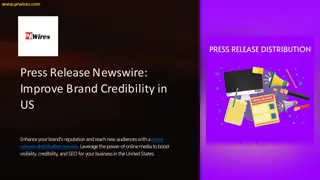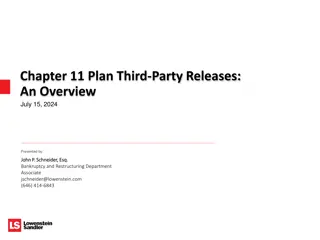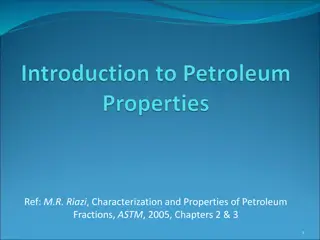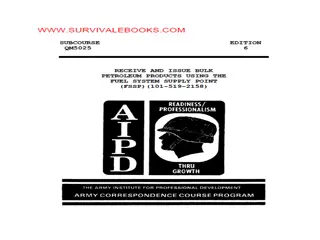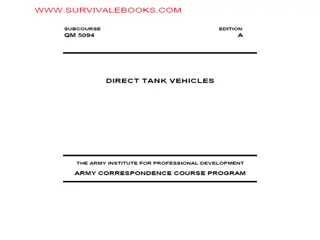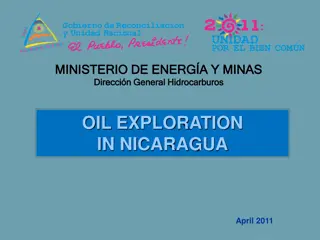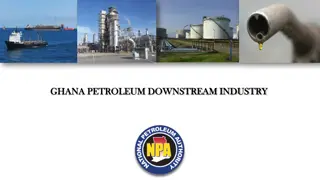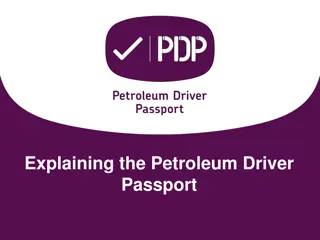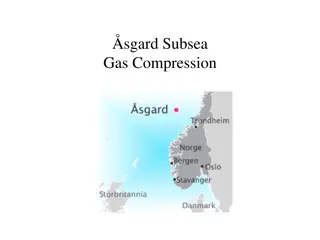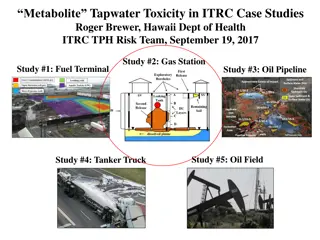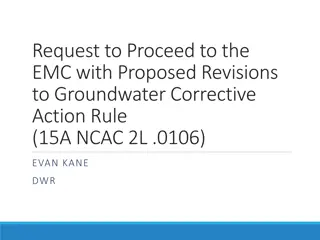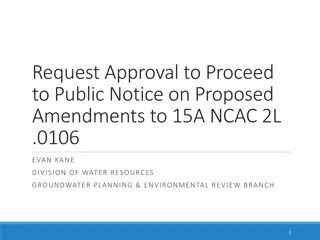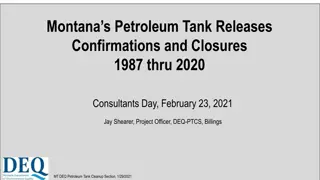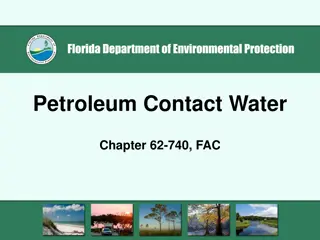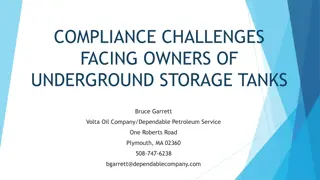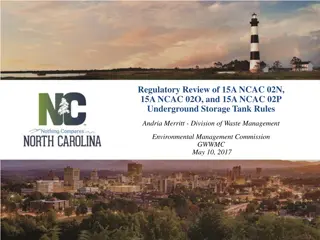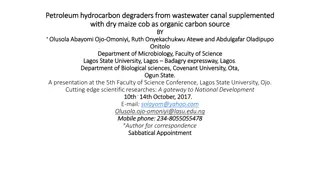Rules for Treating Petroleum Releases: 15A NCAC 02L Section
The rule-making aims to establish consistent rules for addressing petroleum releases, specifically focusing on risk-based remediation for non-UST petroleum releases. The new rules in the 15A NCAC 02L Section aim to prevent misuse of statutes and federal regulations. A comparison is made between non-UST and UST petroleum rules, highlighting differences in requirements. Sections such as 15A NCAC 02L..0501 define the purpose and scope, emphasizing protection of human health, the environment, and State waters. Definitions in 15A NCAC 02L..0502 clarify terms like aboveground storage tanks, discharge, operator, and owner.
Download Presentation

Please find below an Image/Link to download the presentation.
The content on the website is provided AS IS for your information and personal use only. It may not be sold, licensed, or shared on other websites without obtaining consent from the author. Download presentation by click this link. If you encounter any issues during the download, it is possible that the publisher has removed the file from their server.
E N D
Presentation Transcript
Introduction The intent of this rule-making is to adopt rules to treat petroleum releases in a consistent manner. The proposed rules allow risk-based remediation for petroleum non-UST releases and will be created in 15A NCAC 02L Section .0500. The new section is to avoid the improper use of statute and federal regulations as are referenced in 15A NCAC Section .0400. Petroleum non-UST releases have different statutory requirements than petroleum UST releases. Petroleum UST releases have other requirements to ensure they are eligible for the financial assurance (required by federal regulation) provided by the Trust Fund. 2
Comparison of Petroleum Non-UST Rules with UST Rules In the following slides, text in red has been added, red strike out indicates removed text and green indicates changes in the text. 3
15A NCAC 02L .0501 PURPOSE AND SCOPE (a) The purpose of this Section is to establish procedures for risk-based assessment and corrective action sufficient to: (1) protect human health and the environment; (2) abate and control contamination of the waters of the State as deemed necessary to protect human health and the environment; (3) permit management of the State's groundwaters to protect their designated current usage and potential future uses; (4) provide for anticipated future uses of the State's groundwater; (5) recognize the diversity of contaminants, the State's geology and the characteristics of each individual site; and (6) accomplish these goals in a cost-efficient manner to assure the best use of the limited resources available to address groundwater pollution within the State. (b) The applicable portions of Section .0100 not specifically excluded apply to this Section. History Note: Authority G.S. 143-215.2; 143-215.3(a)(1); 143B-282; Eff. Month 1, year.. 4
15A NCAC 02L .0502 DEFINITIONS The definitions as set out in 15A NCAC 02L .0102 apply to this Section, except that the following definitions apply throughout this Section: (1) "Aboveground storage tank" or "AST" means any one or a combination of tanks (including underground pipes connected thereto) that is used to contain an accumulation of petroleum. (2) "AST system" means an aboveground storage tank , connected underground piping, underground ancillary equipment, and containment system, if any". (3) "Discharge" means, but is not limited to, any emission, spillage, leakage, pumping, pouring, emptying, or dumping of oil into groundwater or surface water or upon land in such proximity to such water that it is likely to reach the water and any discharge upon land which is intentional, knowing or willful. (4) "Operator" means any person in control of, or having responsibility for the daily operation of the AST system. (5) "Owner"" means any person who owns a petroleum aboveground storage tank or other non-UST petroleum tank, stationary or mobile, used for storage, use, dispensing, or transport. 5
(6) "Person" means an individual, trust, firm, joint stock company, Federal agency, corporation, state, municpality, commission, political subdivision of a state, or any interstate body. "Person" also includes a consortium, a joint venture, a commercial entity, and the United States Government. (7) "Petroleum" is defined in G.S. 143-215.94A(10). (8) "Release" means any spilling, leaking ,emitting, discharging, escaping, or leaching or disposing into groundwater, surface water, or surface or subsurface soils. (9) "Tank" is a device used to contain an accumulation of petroleum and constructed of non-earthen materials (e.g., concrete, steel, plastic) that provides structural support. History Note: Authority G.S. 143-212(4); 143-215.2; 143-215.3(a)(1); 143-215.77; 143B-282; Eff. Month 1, year.. 6
15A NCAC 02L .0503 RULE APPLICATION from a "commercial underground storage tank" or a "noncommercial underground storage tank," as those terms are defined in G.S. 143-215.94A, which is reported on or after the effective date of this Section. This Section shall apply to any discharge or release from a "commercial underground storage tank" or a "noncommercial underground storage tank," as those terms are defined in G.S. 143-215.94A which is reported before the effective date of this Section as provided in 15A NCAC 02L .0416 of this Section. The requirements of this Section shall apply to the owner and operator of a petroleum aboveground storage tank or other non-UST petroleum tank, stationary or mobile the underground storage tank, from which a discharge or release occurred a landowner seeking reimbursement from the Commercial Leaking Underground Storage Tank Fund or the Noncommercial Leaking Underground Storage Tank Fund under G.S. 143-215.94E, and any other person determined to be responsible for assessment and cleanup of a discharge or release from a non-UST petroleum source an underground storage tank, including any person who has conducted or controlled an activity which results in the discharge or release of petroleum or petroleum products (as defined in G.S. 143-215.94A(10)) to the groundwaters of the State, or in proximity thereto; these persons shall be collectively referred to for purposes of this Section as the "responsible party". This Section shall be applied in a manner consistent with the rules found in 15A NCAC 2N in order to assure that the State's requirements regarding assessment and cleanup from underground storage tanks are no less stringent than Federal requirements. This Section applies to any non-UST petroleum discharge discharge or release History Note: Eff. Month 1, year.. Authority G.S. 143-215.2; 143-215.3(a)(1);143B-282; 7
15A NCAC 02L .0504 REQUIRED INITIAL RESPONSE AND ABATEMENT ACTIONS BY RESPONSIBLE PARTY A responsible party shall: (1) take immediate initial response actions to prevent any further discharge or release of petroleum from the non-UST petroleum source underground storage tank; identify and mitigate any fire, explosion or vapor hazard; and report the release within 24 hours, in compliance with NCGS 143-215.83(a), 84(a), and 85(b) comply with the requirements of Rules .0601 through .0604 and .0701 through .0703 and .0705 of Subchapter 02N; (2) perform initial abatement actions to measure for the presence of a release where contamination is most likely to be present and to confirm the precise source of the release; to investigate to determine the possible presence of free product and to begin free product removal immediately; and to continue to monitor and mitigate any additional fire, vapor, or explosion hazards posed by vapors or by free product; and submit a report within 20 days after release confirmation summarizing these initial abatement actions; (2) incorporate the requirements of 15A NCAC 02N .0704 into the submittal required under Item (3) of this Paragraph or the limited site assessment report required under 15A NCAC 02L .0405 of this Section, whichever is applicable. Such submittals shall constitute compliance with the reporting requirements of 15A NCAC 02N .0704(b); (3) remove contaminated soil which would act as continuing source of contamination to groundwater. For a new release, if initial abatement actions involving control and removal of contaminated materials can be initiated within 48 hours; before contaminated materials have the opportunity to impact groundwater; and if remaining soils contain contaminants with levels less than the TPH action level or less than either the soil-to-groundwater or residential MSCCS (whichever is lowest); no further action is necessary. 8
(4) conduct initial site assessment, assembling information about the site and the nature of the release, including but not necessarily limited to the following: (a) Site history and site characterization, including but not limited to, data on nature and estimated quantity of release and data form available sources and site investigations concerning surrounding populations, water quality, use, and approximate locations of wells, surface water bodies, and subsurface structures potentially affected by the release, subsurface soil conditions, locations of subsurface utilities, climatological conditions, and land use; (b) Results of free product investigations and free product removal, if applicable; (c) Results of groundwater and surface water investigations, if applicable; (d) Summary of initial response and abatement actions; and submit this information in the report required under Paragraph (5) of this Rule. (5) submit within 90 days of the discovery of the discharge or release an initial assessment and abatement report containing the site characterization information required in Paragraph (4) of this Rule; soil assessment information sufficient to show that remaining unsaturated soil in the side walls and at the base of the excavation does not contain contaminant levels which exceed either the "soil- to-groundwater" or the residential maximum soil contaminant concentrations established by the Department pursuant to 15A NCAC 02L .0511 of this Section, whichever is lower; and documentation to show that neither bedrock nor groundwater was encountered in the excavation (or if groundwater was encountered, that contaminant concentrations in groundwater were equal to or less than the groundwater quality standards established in 15A NCAC 2L .0202). If such showing is made, the discharge or release shall be classified as low risk by the Department. History Note: Authority G.S. 143-215.2; 143-215.3(a)(1); 143-215.94A; 143-215.94E; 143-215.94T; 143-215.94V; 143B-282; Eff. Month 1, year.. 9
15A NCAC 02L .0505 REQUIREMENTS FOR LIMITED SITE ASSESSMENT If the required showing cannot be made under 15A NCAC 02L .0504 .0404 of this Section, submit within 120 days of the discovery of the discharge or release, or within such other greater time limit approved by the Department, a report containing information needed by the Department to classify the level of risk to human health and the environment posed by a discharge or release under 15A NCAC 02L .0506 .0406 of this Section. Such report shall include, at a minimum: (1) a location map, based on a USGS topographic map, showing the radius of 1500 feet from the source area of a confirmed release or discharge and depicting all water supply wells and, surface waters and designated wellhead protection areas as defined in 42 U.S.C. 300h-7(e) within the 1500-foot radius. For purposes of this Section, source area means point of release or discharge from the non-UST petroleum source or, if the point of release cannot be determined precisely, source area is defined as the area of highest contaminant concentrations underground storage tank system; (2) Substantially matches .0400 language. (3) Substantially matches .0400 language. (4) a determination of whether vapors from the discharge or release pose a threat of explosion due to the accumulation of vapors in a confined space, pose a risk to public health from exposure, or pose any other serious threat to public health, public safety or the environment; (5) scaled site map(s) showing the location of the following which are on or adjacent to property where the source is located: site boundaries, roads, buildings, basements, floor and storm drains, subsurface utilities, septic tanks and leach fields, underground and aboveground storage tank systems, monitoring wells, water supply other drainage features, borings and the sampling points; the wells, surface water bodies and 10
(6) actions: the results from a limited site assessment which shall include the following (a) concentration levels of soil and, if possible, groundwater contamination and free product accumulations. (b) Install as many monitoring wells within the area of maximum soil or groundwater contamination as needed to determine the groundwater flow direction and maximum concentrations of dissolved groundwater contaminants or accumulations of free product, to include at a minimum three monitoring wells, unless a greater or lesser number are specified for a particular site by the Department ; during well construction, collect and analyze soil samples, which should represent the suspected highest contaminant-level locations by exhibiting visible contamination or elevated levels of volatile organic compounds, from successive locations at five-foot depth intervals in the boreholes of each monitoring well within the unsaturated zone; collect potentiometric data from each monitoring well; and collect and analyze groundwater or measure the amount of free product, if present, in each monitoring well; Determine the presence, the lateral and vertical extent, and the maximum 11
(7) (Substantially matches .0400 language.) (8) (Substantially matches .0400 language.) (9) (Substantially matches .0400 language.) (10) names and current addresses of all responsible parties for all petroleum sources for which a discharge or release is confirmed, the owner(s) of the land upon which such petroleum sources are located, and all potentially affected real property owners. Documentation of ownership of ASTs or other sources and of the property upon which a source is located should be provided. When considering a request from a responsible party for additional time to submit the report, the Division shall consider the extent to which the request for additional time is due to factors outside of the control of the responsible party, the previous history of the person submitting the report in complying with deadlines established under the Commission's rules, the technical complications associated with assessing the extent of contamination at the site or identifying potential receptors, and the necessity for immediate action to eliminate an imminent threat to public health or the environment. History Note: 215.94E; 143-215.94T; 143-215.94V; 143B-282; Eff. Month 1, year.. Authority G.S. 143-215.2; 143-215.3(a)(1); 143-215.94A; 143- 12
15A NCAC 02L .0506 DISCHARGE OR RELEASE CLASSIFICATIONS Rule .506 had no major modifications. 13
15A NCAC 02L .0507 RECLASSIFICATION OF RISK LEVELS (a) Substantially matches .0400 language. (b) Substantially matches .0400 language. (c) Substantially matches .0400 language except as follows: Additionally, if a corrective action plan or groundwater monitoring plan is required under this Paragraph, the responsible party shall demonstrate that the groundwater cleanup levels are sufficient to prevent a violation of: (1) Text unchanged. (2) the standards contained in 15A NCAC 02L .0202 in a deep aquifer as described in 15A NCAC 02L .0506(2)(b) .0406(2)(b) of this Section; and (3) Text unchanged. (d) If the risk posed by a discharge or release is determined by the Department to be a low risk, the Department shall notify the responsible party that no cleanup, no further cleanup or no further action will be required by the Department, unless the Department later determines that the discharge or release poses an unacceptable risk or a potentially unacceptable risk to human health or the environment. No notification will be issued pursuant to this Paragraph, however, until the responsible party has completed soil remediation pursuant to 15A NCAC 02L .0508 .0408 of this Section or as closely thereto as economically or technologically feasible; has submitted proof of public notification and has recorded any land-use restriction(s), if required; and paid any applicable statutorily authorized fees. The issuance by the Department of a notification under this Paragraph shall not affect any private right of action by any party which may be affected by the contamination. History Note: Authority G.S. 143-215.2; 143-215.3(a)(1); 143-215.94A; 143-215.94E; 143-215.94T; 143-215.94V; 143B-282; Eff. Month 1, year.. 14
15A NCAC 02L .0508 ASSESSMENT AND REMEDIATION PROCEDURES Rule 0508 had no major modifications. 15A NCAC 02L .0509 NOTIFICATION REQUIREMENTS Rule .0509 had no major modifications. 15
15A NCAC 02L .0510 DEPARTMENTAL LISTING OF DISCHARGES OR RELEASES To the extent feasible, the Department shall maintain in each of the Department's regional offices a list of all non-UST petroleum petroleum underground storage tank discharges or releases discovered and reported to the Department within the region on or after the effective date of this Section and all petroleum underground storage tank discharges or releases for which notification was issued under 15A NCAC 02L .0407(d) of this Section by the Department on or after the effective date of this Section. History Note: 215.94E; 143-215.94T; 143-215.94V; 143B-282; Eff. Month 1, year. Authority G.S. 143-215.2; 143-215.3(a)(1); 143-215.94A; 143- 16
15A NCAC 02L .0511 ESTABLISHING MAXIMUM SOIL CONTAMINATION CONCENTRATIONS For purposes of risk-based assessment and remediation for non-UST petroleum releases, refer to 15A NCAC 02L .0411 for establishment of maximum soil contamination concentrations. History Note: Eff. Month 1, year. Authority G.S. 143-215.2; 143-215.3(a)(1); 143B-282; 15A NCAC 02L .0512 ANALYTICAL PROCEDURES FOR SOIL SAMPLES For purposes of risk-based assessment and remediation for non-UST petroleum releases, refer to 15A NCAC 02L .0412 for analytical procedures for soil samples. History Note: Eff. Month 1, year. Authority G.S. 143-215.2; 143-215.3(a)(1); 143B-282; 17
15A NCAC 02L .0513 ANALYTICAL PROCEDURES FOR GROUNDWATER SAMPLES For purposes of risk-based assessment and remediation for non-UST petroleum releases, refer to15A NCAC 02L .0413 for analytical procedures for groundwater samples. History Note: Eff. Month 1, year.. Authority G.S. 143-215.2; 143-215.3(a)(1); 143B-282; 15A NCAC 02L .0514 REQUIRED LABORATORY CERTIFICATION In accordance with 15A NCAC 02H .0804, laboratories are required to obtain North Carolina Division of Water Quality laboratory certification for parameters that are required to be reported to the State in compliance with the State's surface water, groundwater and pretreatment rules. History Note: 215.94E; 143-215.94T; 143-215.94V; 143B-282; Eff. Month 1, year.. Authority G.S. 143-215.2; 143-215.3(a)(1); 143-215.94A; 143- 18
15A NCAC 02L .0515 DISCHARGES OR RELEASES FROM OTHER SOURCES This Section shall not relieve any person responsible for assessment or cleanup of contamination from a source other than a non-UST petroleum release commercial or noncommercial underground storage tank from its obligation to assess and clean up contamination resulting from such discharge or releases. History Note: 215.94E; 143-215.94T; 143-215.94V ; 143B-282; Eff. Month 1, year. Authority G.S. 143-215.2; 143-215.3(a)(1); 143-215.94A; 143- 19




